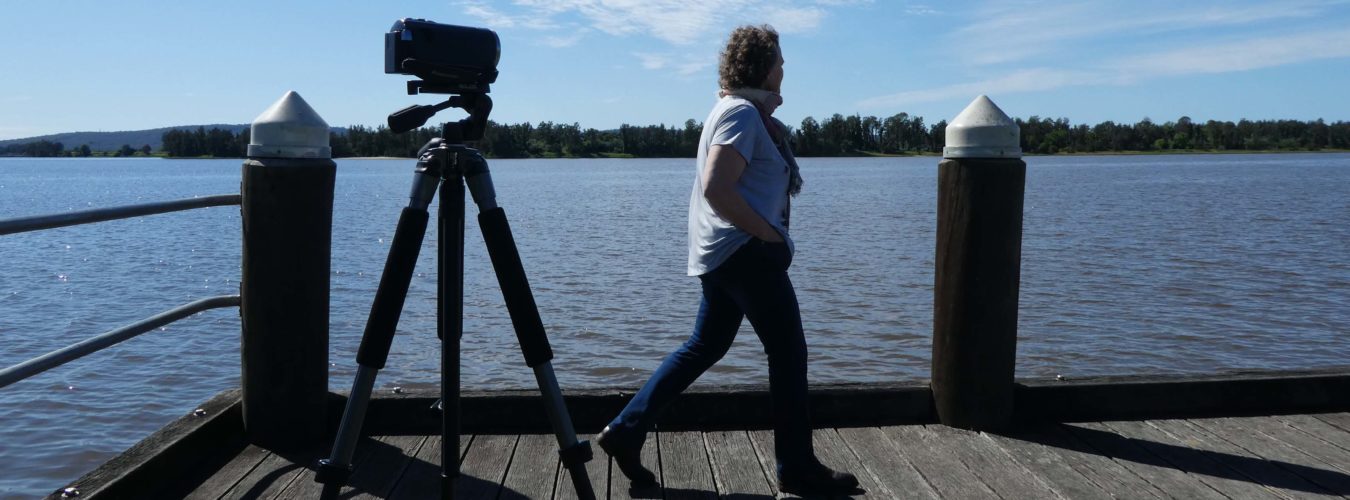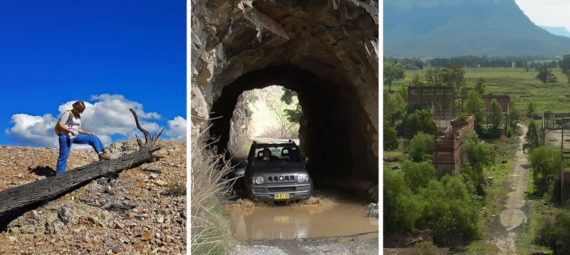1. Travel back in time
Turn off the Gwydir Highway just out of Grafton onto the Old Glen Innes Road for a day trip back in time. The 180km road opened in 1867, following tracks carved out by bullock drays in the 1840s. The road was the only link between the towns of the New England and the NSW coast for almost 100 years. Cobb and Co ran what must have been a tortuous mail and passenger service between Glen Innes and Grafton which took three gruelling days. Timber getters and farming types also used this route, and when gold was found, short-lived settlements sprang up. The road passes beside spectacular wild rivers and through breathtaking scenery. Highlights of this trip are a river crossing where the giant pylons of a former bridge are scattered about after a massive flood in the 1940s. There’s an eerie ghost town, and you’ll drive through a hand carved tunnel hacked through sheer rock. Further on there’s the saddest of war memorials and finally a lookout used by a notorious local bushranger.
2. Walk through a petrified forest
Swansea is the largest town in the City of Lake Macquarie and is perhaps best known for fishing, boating, beaches and tourism. But it’s got a hidden story to tell. Situated where the lake opens to the sea, Swansea Bridge opens on the hour to let boats move in and out of the lake and there is a shopping centre nearby with some nice cafes. But what is not widely known about Swansea is it’s very ancient history. On the rock platform at the end of Reids Reserve, a petrified forest of a now extinct species of tree can be found. Dotted here and there across the rocks are the fossilised remains of tree stumps, which become quite obvious once you start looking. The trees were snapped off at the base by the force of a volcanic eruption which occurred 250 million years go somewhere about 20km away to the east. If you look carefully, you will also see leaf fossils on rocks around the platform. It’s a surprising and fascinating glimpse into the very distant past.
3. See a mountain on fire for 6000 years
If you come to Burning Mountain expecting to see the smoke and flames that are perhaps implied in the name, you might be a bit disappointed. Burning Mountain is just not that kind of fire, but it is a nonetheless impressive geological oddity. Information displays in the reserve say this coal seam has been burning steadily across the landscape, about 30m below ground, for at least 6000 years – and possibly for as long as 500,000 years. Underground coal fires are common enough throughout the world, often in coal mines. But naturally occurring ones that have burned over such an extended period are rare. This is the only conserved one in Australia and one of only a few known in the world. Burning Mountain reserve is on the New England Highway about 20km from Scone and a bit beyond the village of Wingen. There’s a fair bit of parking and picnic areas at the start. The walk is not too gruelling, but there are a few stairs. How did it start? What keeps it going?
4. Get on board for a lost railway
This is the quirky tale of an incredible bridge, a scheming politician and a rail tunnel that never worked. It’s the story of how rail first crossed the Blue Mountains. It had it’s triumphs and it had its failures, but ultimately it was a testament to perseverance! Today’s western line owes much to this story. Go and see the the historic engineering feat – the Knapsack Viaduct – which was a key link in the rail line over the mountains and in its day the biggest such viaduct in Australia. It’s an easy walk and you can take the steps and paths down to the foot of this great stone bridge which gives you a real sense of its scale. Checkout the zig zag system used o get the trains up the slope and a station which was built by a politician to take trains to his blue mountains holiday home! See the railway tunnel so poorly designed it had to be abandoned and spent many years housing chemical weapons during WWII before being used for mushroom farming. The township of Glenbrook was lovely with lots of nice cafes and restaurants.
5. Discover a convict road
Here’s an easy but quite amazing trip into Australia’s convict past. The Great North Road was built over 10 gruelling years from 1826 to link Sydney with the Hunter Valley. Most of this road is still being used used today but hidden beneath modern suburban thoroughfares. You can still see large sections of it and admire the brilliant engineering works created by hundreds of convicts – many working in leg-irons. Relics such as stone retaining walls, wharves, culverts, bridges and buttresses can still be seen along the entire length of the Great North Road – in Sydney suburbs like Epping and Gladesville, at Wisemans Ferry or Wollombi, Bucketty or Broke, or when walking in Dharug and Yengo National Parks. Take the particularly interesting drive between the locality of Bucketty via Wollombi Rd to the historic village of St Albans where you can stop for lunch. St Alban’s historic pub is really woth a look. Then drive on to Dharug National Park where you can walk The Divine’s hill section of this road and see many well sign posted examples of convict building skill.
6. Find hidden ruins in a giant valley
Take the road less travelled into the Capertee Valley – the second largest canyon in the world – on a journey to the village of Glen Davis. The village is 70 kilometres north of Lithgow in the Capertee Valley, and the eerie ruins there are all that remains of the only attempt to commercially produce petrol from shale oil in Australia. Guided tours of the ruins are run every Saturday at 2pm. Oil shale was first discovered in the northern side of the Capertee Valley around 1865. Glen Davis still has the largest seam of high grade oil shale in the world. Wartime petrol shortages were the impetus for a revival of oil shale mining and treatment in 1940. In 1940 the first oil was produced. 170 miners were employed. At its height, 2500 people lived in the immediate area. But things never really went too well for the works or the mine – and a combination of industrial strife, technical problems and insufficient supply of oil shale forced the works to close. The village today has just a handful of residents, a camping ground and the surprisingly grand Glen Davis Hotel which is now a guest house. You can by a drink or a snack in the camping ground store – but that’s about it. There’s no petrol station. The incredible beauty and grandeur of the towering cliffs that surround the village are worthy of a look in themselves. The valley is also a favoured haunt of bird watchers too – and you’ll find a series of signed bird watching points around the town. To get there, turn off the Castlereagh highway (between Lithgow and Mudgee) at the town of Capertee. Follow the road for about 20km through spectacular scenery until you reach an intersection – turn right for Glen Davis.
7. Explore an industrial revolution town
Lithgow is a town with a colourful industrial past. There is no escaping the way heavy industry has shaped it. That engineering marvel – the Great Zig Zag railway, coal mines (some still operate), Australia’s first steel works, a small arms factory, and a major pottery kiln once thrived. Many a street name bears silent witness to all kinds of industries – Gas Works Lane, Brewery Lane, Enfield Avenue (a type of rifle famously produced in Lithgow) Union Street. We loved this industrial revolution town’s unique look at feel. A highlight was a stop at the stark industrial ruins in Blast Furnace Park – the birthplace of the modern Australian steel industry which later moved to Port Kembla. The Small Arms Factory Museum was fascinating and the view from Hassan’s Walls lookouts was quite stunning.
8. Wander a town frozen in time
About half way between Mt Victoria and Lithgow on the Great Western Highway there is a little village frozen in time. It lies at the bottom of that colonial era road-building masterpiece – Victoria Pass. Even today – more than 180 years since horses and carts clattered along its route – this road still carries traffic down from the Blue Mountains and off into the wide expanses of western NSW. The pass leads down the mountains to the historic settlement of Hartley. This is one of those boom and bust stories, of changing fortunes and changing times. Hartley is 133 kilometres from the centre of Sydney. It started as an important stopping point for travellers crossing the Blue Mountains in the first decades of the 1800s. But it was eventually overtaken by the railway that passed it by and modern motor vehicles that could travel further and it fell through the cracks of history. Now there is a well preserved collection of wonderful historic buildings run by the National Parks and Wildlife Service. There’s a visitor centre, art gallery and cafe. Well worth a trip.
9. Visit Newcastle’s hidden gem
Stockton is just a five minute ferry ride from the heart of Newcastle and yet has the charm and laid back atmosphere of a coastal country town. It feels like you’re on holidays. Industrial areas have given way to well-used parkland, cycle ways and walking tracks. On one side is the busy shipping lane of the Hunter River and Newcastle Port. The other side is fringed by a spectacular beach which runs 33km north. Stockton is the only northern residential suburb of Newcastle, and one of the first settlements established after the founding of Newcastle in the last years of the 1700s and it’s got a colourful history too – pirates, shipwrecks, ship builders, coal and much more.

